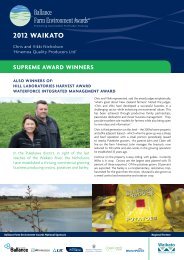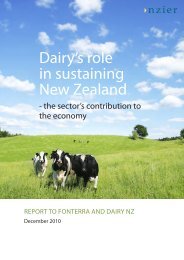NZIER report on compensation for transmission infrastructure
NZIER report on compensation for transmission infrastructure
NZIER report on compensation for transmission infrastructure
You also want an ePaper? Increase the reach of your titles
YUMPU automatically turns print PDFs into web optimized ePapers that Google loves.
the degree of sterilisati<strong>on</strong> (Hydro-Québec 2000). This was the <strong>on</strong>ly example we<br />
found, however, of blanket compensati<strong>on</strong> at 100 percent of market value <strong>for</strong> the<br />
whole easement area (other than <strong>for</strong> <strong>for</strong>estry as discussed below).<br />
At times n<strong>on</strong>e of the land under transmissi<strong>on</strong> lines is able to be used in the same<br />
manner as surrounding land. The prime example of this is when easements are built<br />
through commercial <strong>for</strong>ests. Trees are unable to be grown <strong>on</strong> easements because of<br />
the risk of damage to power lines from mature trees growing taller than such wires.<br />
Hutchis<strong>on</strong> and Rowan-Robins<strong>on</strong> (2000) refer to this as a 100 percent sterilisati<strong>on</strong><br />
rate, as the earning capability of the affected land is reduced to zero. In the case of<br />
<strong>for</strong>estry, landowners usually receive compensati<strong>on</strong> at 100 percent of the market<br />
value of the land <strong>for</strong> the total easement area (see, <strong>for</strong> example, Beesley 2008, Hamer<br />
and O‟Brian 2007, Hydro-Québec 2000, or Hutchis<strong>on</strong> et al 1998).<br />
There is an argument, however, that even in the case of 100 percent sterilisati<strong>on</strong>,<br />
such as with commercial <strong>for</strong>ests, the utility gets less than full ownership of the land<br />
and as such should not pay full land market price. Hutchis<strong>on</strong> et al (1998) menti<strong>on</strong> a<br />
United Kingdom based electrical company paying compensati<strong>on</strong> at 85 percent of<br />
open market value <strong>for</strong> easements across <strong>for</strong>estry <strong>for</strong> this reas<strong>on</strong>. This was, however,<br />
an old example, and the <strong>on</strong>ly <strong>on</strong>e we found of <strong>for</strong>estry compensati<strong>on</strong> at less than 100<br />
percent of the market value of the total easement area. It appeared to be driven by<br />
the utilities bargaining strength rather than efficiency or equity.<br />
As discussed above in secti<strong>on</strong> 2, <strong>on</strong>ly by assigning the appropriate cost to an<br />
easement can the most efficient decisi<strong>on</strong> be made about how to transmit power.<br />
3.4.2 Land market value<br />
In the countries we looked at the market value of land <strong>for</strong> pricing an easement is<br />
generally based <strong>on</strong> recent market sale prices of similar types of land (see <strong>for</strong><br />
example Hutchis<strong>on</strong> et al 1998). The value of land is multiplied by the area needed <strong>for</strong><br />
the easement and the appropriate sterilizati<strong>on</strong> rate, as discussed above.<br />
In practice, as noted by Beesley (2008), Hutchis<strong>on</strong> et al (1998) and Solum (1985),<br />
land valuati<strong>on</strong>s generally suffer from a degree of inaccuracy. Quite often there is <strong>on</strong>ly<br />
a very small amount of open market sales evidence to base values <strong>on</strong>. Additi<strong>on</strong>ally<br />
the property market reacts <strong>on</strong>ly slowly to changes in underlying fundamentals and, as<br />
such, prices do not always reflect all available in<strong>for</strong>mati<strong>on</strong> (Hutchis<strong>on</strong> et al 1998).<br />
According to Solum (1985) land values, as estimated by real estate appraisers, are<br />
influenced by opini<strong>on</strong>.<br />
One of the landowners we spoke with provided an example of Transpower wanting to<br />
purchase land during a dip in land prices. There was a general reluctance to sell as<br />
landowners were of the opini<strong>on</strong> that they would receive more per area if they waited.<br />
This behaviour is comm<strong>on</strong> across all types of property owners. When house sales<br />
prices decline, <strong>for</strong> example, there is a decrease in the number of people selling<br />
houses as they wait <strong>for</strong> prices to improve. There is some c<strong>on</strong>cern, however, that<br />
<str<strong>on</strong>g>NZIER</str<strong>on</strong>g> – Compensati<strong>on</strong> <strong>for</strong> transmissi<strong>on</strong> <strong>infrastructure</strong> 20
















